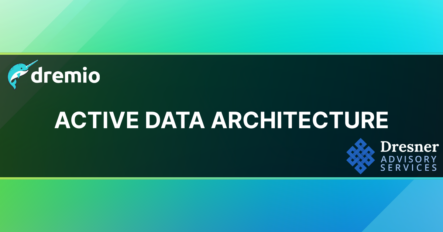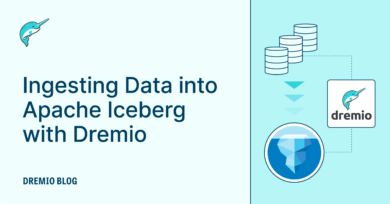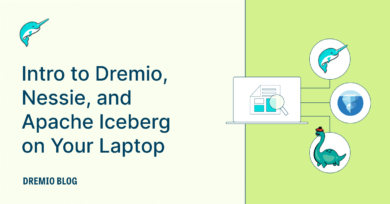13 minute read · May 5, 2025
Dremio’s Leading the Way in Active Data Architecture
· Principal Product Marketing Manager

Modern data teams are under pressure to deliver faster insights, support AI initiatives, and reduce architectural complexity. To meet these demands, more organizations are adopting active data architectures—frameworks that unify access, governance, and real-time analytics across hybrid environments. In the newly released Dresner 2025 Active Data Architecture Report, Dremio was ranked #1—recognized as a top performer across semantic layer, governance, scale, performance, and dynamic optimization.
This report validates what customers already know: Dremio’s Intelligent Lakehouse Platform is a powerful enabler of fast, governed, and flexible analytics in the era of distributed data.
(Dresner Advisory Services, LLC-Active Data Architecture® Report 2025 Edition page 112)
What Is Active Data Architecture—and Why Does It Matter?
Active data architecture is an architectural approach—that enables organizations to unify and optimize access to data across distributed systems. At its core, it establishes a platform-neutral layer of abstraction that decouples how data is managed, governed, and accessed from the underlying physical infrastructure. This architectural layer allows data to be organized and utilized in a consistent, system-agnostic way.
Rather than relying on rigid, siloed architectures, active data architecture is built from components across key domains such as data integration, engineering, governance, metadata management, and analytics infrastructure. Organizations can tailor their implementations—narrow for specific use cases or broad for enterprise-wide coverage—depending on their goals.
Some key capabilities of active data architecture include:
- Virtualized and distributed data access to support real-time, scalable insights
- Semantic layers that present aligned, business-friendly data views
- Robust governance and security across hybrid and multi-cloud environments
- Dynamic performance optimization to control cost and improve responsiveness
One of the foundational goals of active data architecture is to enable the creation of reusable, governed data products—datasets that are purpose-built for achieving business value. By decoupling data use and control from the technical systems that store it, organizations can elevate data into a strategic asset, ready to serve analytics and operational needs across the enterprise.
While data mesh and data fabric are commonly mentioned in this space, they tend to focus more narrowly on how distributed data is connected and accessed. Active data architecture, on the other hand, encompasses a broader vision—covering everything from semantic alignment to metadata intelligence and policy-driven governance.
Dremio was recognized as a leader because it delivers on the most important capabilities for active data architecture:
- Business-Friendly Semantic Layer Access
- Centralized and Intelligent Data Catalog
- Autonomous Real-Time Query Acceleration
- Granular Governance and Security Controls
- Flexible Cloud and Hybrid Deployments
1. A Semantic Layer That Unifies Access and Discovery
One of the most important use cases for active data architecture is delivering a semantic layer—a unified, governed abstraction that simplifies access to distributed data. Dresner found that 84% of organizations consider the semantic layer a critical component of active data architecture—underscoring the importance of delivering consistent, governed access to distributed data. Dremio’s built-in semantic layer provides this unified experience by abstracting physical data structures into business-friendly, SQL-accessible views. Users can organize data into logical environments and layered spaces—Preparation, Business, and Application—supporting clean separation between raw data, modeled entities, and end-user consumption. This structure improves performance, usability, and governance while enabling fast, self-service access to trusted data.
Dremio enhances the semantic layer with rich metadata capabilities like labeling, tagging, and wiki documentation, making it easy to discover and understand datasets across the organization. AI-powered semantic search, visual data lineage, and role-based access controls ensure users find the right data while maintaining security and compliance. Backed by the Dremio Enterprise Catalog, this semantic layer delivers a governed, scalable foundation for reusable data products and real-time analytics across companies data environments. .
(Dresner Advisory Services, LLC-Active Data Architecture® Report 2025 Edition page 78)
Try Dremio’s Interactive Demo
Explore this interactive demo and see how Dremio's Intelligent Lakehouse enables Agentic AI
2. A Robust Centralized and Intelligent Data Catalog
In the Dresner report, a data catalog and broader metadata management are cited as among the most critical technologies for enabling an active data architecture. As organizations deal with increasingly complex, distributed data environments, having a centralized, intelligent catalog becomes essential for managing, discovering, and governing data at scale.
Dremio addresses this need through its Enterprise Catalog, , a powerful, unified metadata layer built on Apache Polaris. The Enterprise Catalog provides a central location to register, organize, and tag datasets—whether they reside in the cloud, on-premises, or across multiple sources. It tracks lineage, enforces fine-grained access controls, and supports tagging and classification of sensitive or business-critical data.
By integrating seamlessly with Dremio’s semantic layer and governance model, the Enterprise Catalog enables organizations to deliver trusted, governed, and reusable data products—one of the foundational use cases of active data architecture. It abstracts complexity from end users while giving platform teams full control and visibility, accelerating insight delivery and supporting real-time access across a company’s data landscape.
( Dresner Advisory Services, LLC-Active Data Architecture® Report 2025 Edition - page 47)
3. Autonomous Optimization with Reflections
The Dresner report highlights that performance and scalability are foundational to active data architecture, especially in today’s distributed, virtualized environments. In fact, 90% of organizations rated capabilities like data persistence and caching as critically important, with strong emphasis also placed on dynamic query optimization. These capabilities are essential for delivering fast insights across increasingly complex data landscapes.
Dremio’s Autonomous Reflections are a clear example of this differentiation. They provide intelligent materializations that dynamically adapt to query patterns—no manual tuning or pipeline engineering required. These materializations act like a persistent, always-fresh cache that accelerates queries automatically, even as data changes or new workloads are introduced.
Unlike traditional systems that require developers or IT teams to manually configure indexes, caching strategies, or pre-aggregations, Dremio continuously monitors workload patterns and creates optimized views behind the scenes. This eliminates the need for upfront modeling work, and significantly reduces the time it takes to deliver insights—especially for virtualized or ad hoc data products. It’s this level of hands-free optimization that sets Dremio apart and aligns with Dresner’s observation that dynamic query repair and optimization remains a rarer capability in the market. Dremio’s ability to deliver true dynamic optimization out of the box aligns with what organizations are seeking from their active data architecture.
.
(Dresner Advisory Services, LLC-Active Data Architecture® Report 2025 Edition - page 56)
4. Integrated Governance Across All Layers
Governance is one of the most critical enablers of active data architecture, according to Dresner, with top priorities including security, privacy, data quality, and support for open source and open formats. In fact, 76% of organizations rated open source and security as critically or very important, followed closely by privacy (75%), data quality (72%), and robust governance models. These findings reflect the growing demand for platforms that can manage distributed data with consistency, transparency, and control—especially as environments become more automated and decentralized.
Governance is a core pillar of Dremio’s active data architecture.. The platform supports column- and row-level access controls to protect sensitive data, implements role-based permissions to manage user entitlements, and enables tag-based policies and lineage tracking to ensure transparency and traceability across data assets.
Dresner emphasized that governance (security, privacy, and quality controls) was a top priority among survey respondents—and Dremio was among the top scorers in this area.
What makes Dremio’s governance model especially compelling is its seamless integration across semantic layers, virtual views, and data products. Policies and permissions are enforced consistently whether users are accessing raw tables, curated views, or federated sources—ensuring trust without sacrificing agility.
Many of these capabilities are powered by the Dremio Enterprise Data Catalog, built on Apache Polaris. The catalog provides centralized metadata management, access control enforcement, and data lineage tracking across all datasets and environments—cloud, on-premises, or hybrid. It allows organizations to manage data definitions, tag sensitive fields, apply fine-grained security, and audit access in a unified, scalable way. This foundation ensures that governance is not bolted on, but inherent in how data is discovered, secured, and consumed across the entire Dremio active data architecture.
(Dresner Advisory Services, LLC-Active Data Architecture® Report 2025 Edition- page 52)
5. Cloud-Ready and Hybrid by Design
Active data architecture is not one-size-fits-all. Though many organizations are looking at cloud deployments, Dresner found that over 60% of organizations prioritize hybrid deployment models with over 25% of organizations indicating that on-premises is still critically important —and Dremio is uniquely positioned to support all deployment options. .
With the Dremio Lakehouse Platform, customers can enable an active data architecture in the cloud, on-premises or in a hybrid environment. Dremio provides the unique capability to allow organizations to analyze data where it resides for AI and BI initiatives, without moving or duplicating data. This location-agnostic architecture gives organizations the flexibility to modernize incrementally, optimize costs, and meet compliance requirements. Dremio's native support for S3, ADLS, on-prem Hadoop environments, and cloud object stores allows teams to unify access across all data, regardless of where it lives.
Additionally, the ability to run Dremio in fully managed cloud services or self-managed environments ensures maximum architectural flexibility. This hybrid readiness means organizations can easily architect for performance, resilience, and data sovereignty .
(Dresner Advisory Services, LLC-Active Data Architecture® Report 2025 Edition - page #38)
A Future-Proof Foundation for Modern AI and Analytics
As the Dresner report makes clear, active data architecture is no longer optional—it’s foundational. And Dremio leads the market with an open, intelligent platform that accelerates time to insight while simplifying governance and architecture.
Whether you’re enabling real-time analytics, creating reusable data products, or scaling AI initiatives, Dremio gives you the flexibility and performance to move faster—without compromise.
To learn more about Active Data Architecture and to get both a summary and the full report. GO HERE


